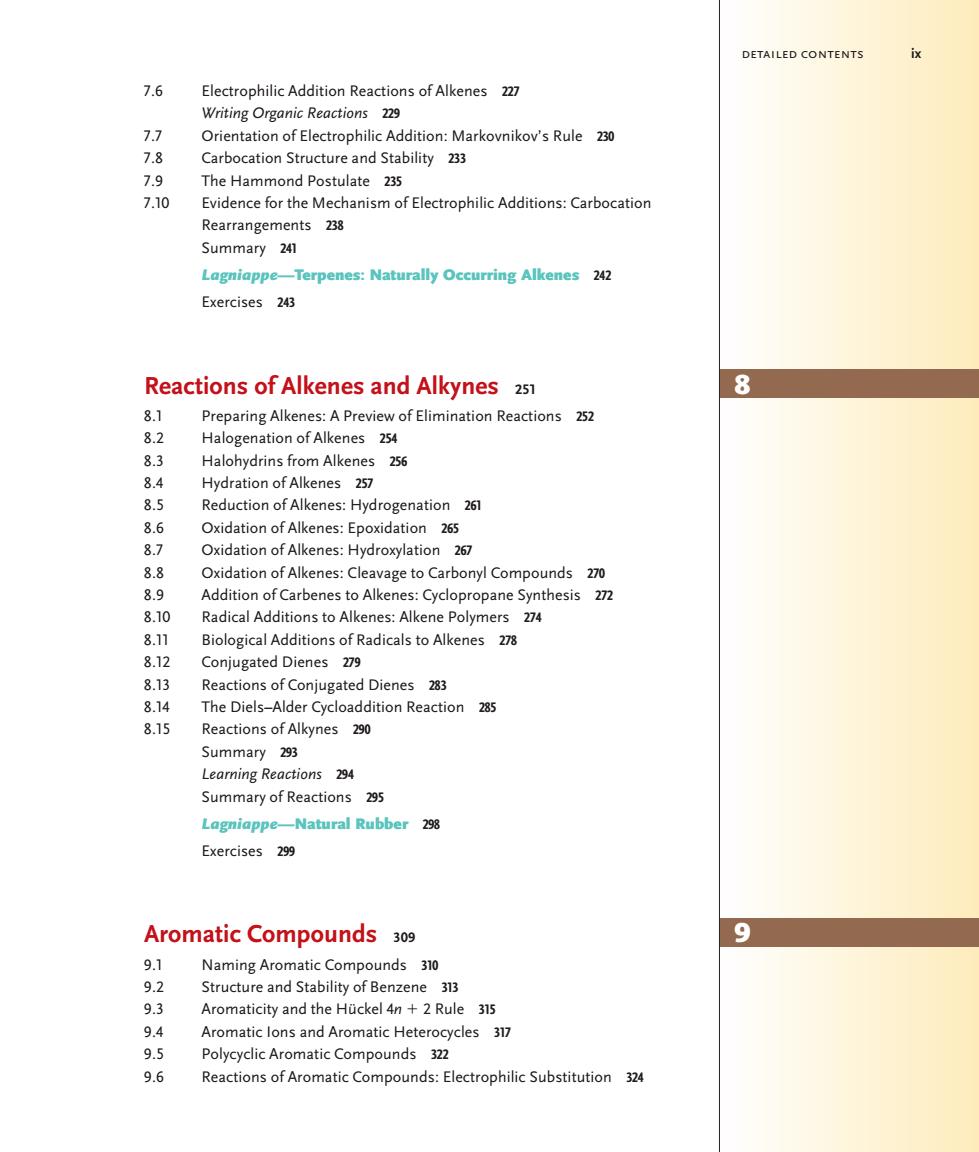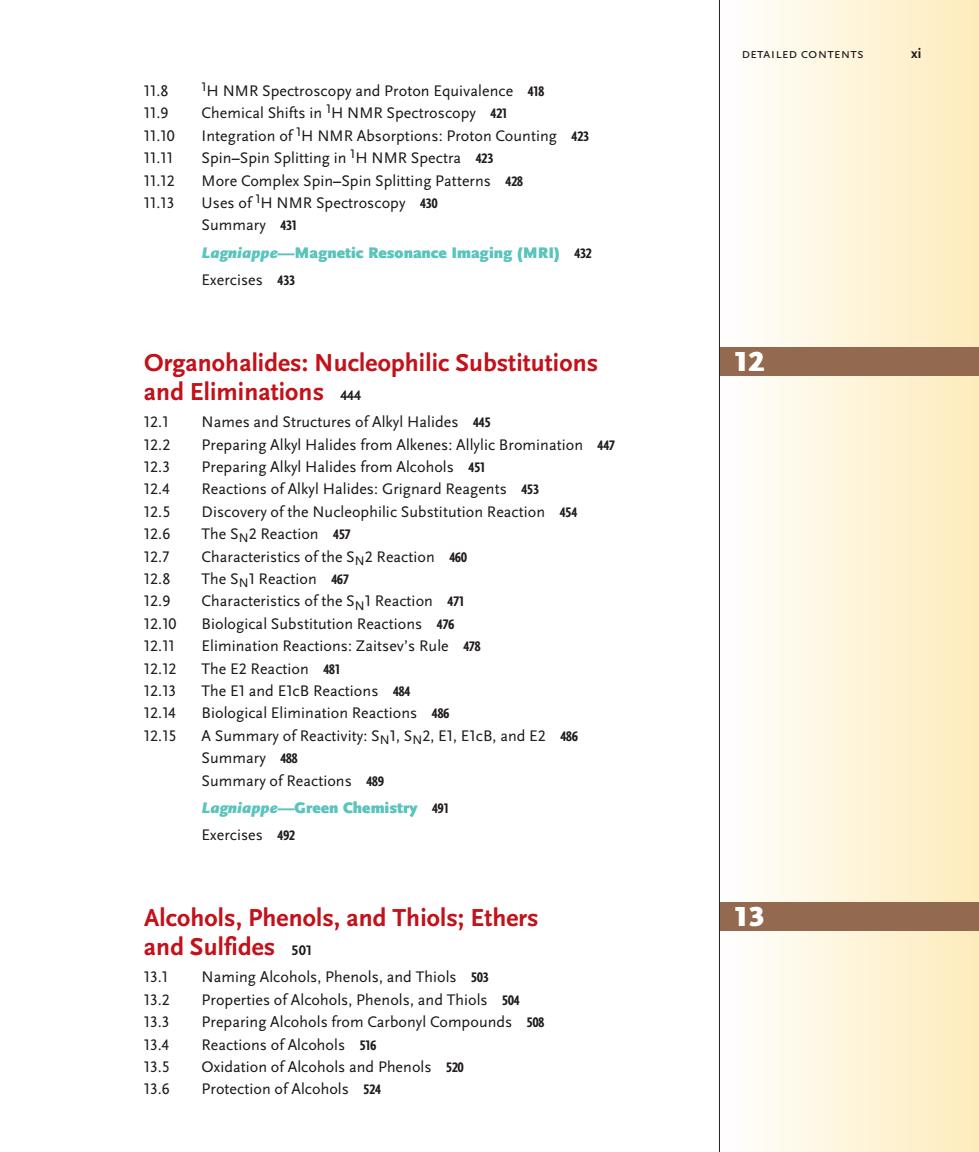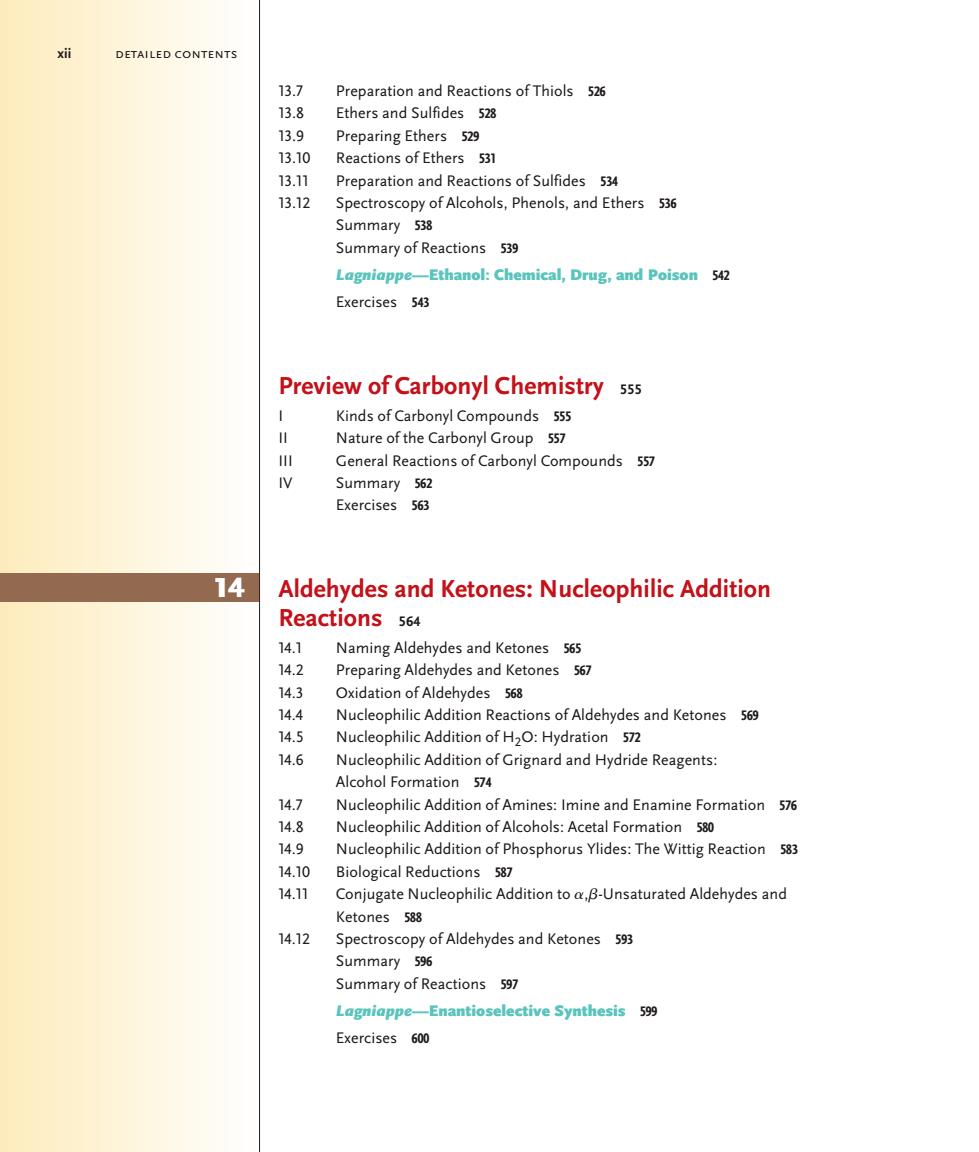
DETAILED CONTENTS 7.6 Electrophilic Addition Reactions of Alkenes 27 Writing Organic Reactions 229 Orientation of Electrophilic Addition:Markovnikov's Rule 230 Carbocation Structure and Stability 233 7.9 The Hammond Postulate 235 7.10 Evidence for the Mechanism of Electrophilic Additions:Carbocation Rearrangements 238 Summary 241 Lagniappe-Terpenes:Naturally Occurring Alkenes 242 Exercises 243 Reactions of Alkenes and Alkynes 251 8 8.1 Preparing Alkenes:A Preview of Elimination Reactions 252 8.2 Halogenation of Alkenes 254 8.3 Halohydrins from Alkenes 26 8.4 Hydration of Alk kenes 257 Reduction of Alkenes:Hydrogenation 261 8.6 Oxidation of Alkenes:Epoxidation 265 Oxidation of Alkenes:Hydroxylation 8.8 Oxidation of Alkenes:Cleavage to Carbonyl Compounds 270 8.9 Addition of Carbenes to Alkenes:Cyclopropane Synthesis 272 8.10 Radical additions to alkenes:alkene polyr mers 274 8.11 Biological Additions of Radicals to Alkenes 27 8.12 Conjugated Dienes 279 8.13 Reactions of Coniugated dienes 283 The Diels-Alder Cycloaddition Reaction 285 Reactions of Alkynes290 Summary 293 Leaming Reactions2 Summary of Reactions 295 Lagniappe-Natural Rubber29 Exercises 299 Aromatic Compounds 309 9 9.1 Naming Aromatic Compounds 310 9.2 Structure and Stability of Benzene 313 9.3 Aromaticity and the Huckel 4n+2 Rule 315 94 Aromatic lons and Aromatic Heterocycles 317 .5 Polycyclic Aromatic Compounds 322 9.6 Reactions of Aromatic Compounds:Electrophilic Substitution 324
detailed contents ix 7.6 Electrophilic Addition Reactions of Alkenes 227 Writing Organic Reactions 229 7.7 Orientation of Electrophilic Addition: Markovnikov’s Rule 230 7.8 Carbocation Structure and Stability 233 7.9 The Hammond Postulate 235 7.10 Evidence for the Mechanism of Electrophilic Additions: Carbocation Rearrangements 238 Summary 241 Lagniappe—Terpenes: Naturally Occurring Alkenes 242 Exercises 243 Reactions of Alkenes and Alkynes 251 8.1 Preparing Alkenes: A Preview of Elimination Reactions 252 8.2 Halogenation of Alkenes 254 8.3 Halohydrins from Alkenes 256 8.4 Hydration of Alkenes 257 8.5 Reduction of Alkenes: Hydrogenation 261 8.6 Oxidation of Alkenes: Epoxidation 265 8.7 Oxidation of Alkenes: Hydroxylation 267 8.8 Oxidation of Alkenes: Cleavage to Carbonyl Compounds 270 8.9 Addition of Carbenes to Alkenes: Cyclopropane Synthesis 272 8.10 Radical Additions to Alkenes: Alkene Polymers 274 8.11 Biological Additions of Radicals to Alkenes 278 8.12 Conjugated Dienes 279 8.13 Reactions of Conjugated Dienes 283 8.14 The Diels–Alder Cycloaddition Reaction 285 8.15 Reactions of Alkynes 290 Summary 293 Learning Reactions 294 Summary of Reactions 295 Lagniappe—Natural Rubber 298 Exercises 299 Aromatic Compounds 309 9.1 Naming Aromatic Compounds 310 9.2 Structure and Stability of Benzene 313 9.3 Aromaticity and the Hückel 4n 2 Rule 315 9.4 Aromatic Ions and Aromatic Heterocycles 317 9.5 Polycyclic Aromatic Compounds 322 9.6 Reactions of Aromatic Compounds: Electrophilic Substitution 324 8 9 39144_ FM_i-xxiv.indd ix 8/26/09 10:48:49 AM�

DETAILED CONTENTS 9.7 Alkylation and Acylation of Aromatic Rings:The Friedel-Crafts Reaction 331 98 Substituent Effects in Electrophilic Substitutions 336 Nucleophilic Aromatic Substitution 344 9.10 Oxidation and Reduction of Aromatic Compounds4 9.1n An Introduction to Organic Synthesis:Polysubstituted Benzenes349 Summary 355 Summary of Reactions 356 Lagniappe-Aspirin,NSAIDs,and COX-2 Inhibitors 357 Exercises 359 10 Structure Determination:Mass Spectrometry, Infrared Spectroscopy,and Ultraviolet Spectroscopy 367 10.1 Mass Spectrometry of Small Molecules:Magnetic-Sector Instruments 368 Interpreting Mass Spectra36 Mass Spectrometry of Some Common Functional Groups 373 10.4 Mass Spectrometry in Biological Chemistry:Time-of-Flight(TOF) Instruments 376 10.5 Spectroscopy and the Electromagnetic Spectrum 377 10.6 Infrared Spectroscopy 380 107 Interpreting Infrared Spectra 381 Infrared Spectra of Some Common Functional Groups 384 Ultraviolet Spectroscopy 389 10.10 Interpreting Ultraviolet Spectra:The Effect of Conjugation 391 10.11 Conjugation,Color,and the Chemistry of Vision39 Summary 394 Lagniappe-Chromatography:Purifying Organic Compounds 395 Exercises 3% 11 Structure Determination:Nuclear Magnetic Resonance Spectroscopy 404 11.1 Nuclear Magnetic Resonance Spectroscopy 405 11.2 The Nature of NMR Absorptions 406 11.3 Chemical Shifts 409 11.4 1NMR Spectroscopy Signal Averaging and FT-NMR 1.5 Characteristics of 13C NMR Spectroscopy 412 11.6 DEPT 13C NMR Spectroscopy 415 111 Uses of 13C NMR Spectroscopy 417
x detailed contents 9.7 Alkylation and Acylation of Aromatic Rings: The Friedel–Crafts Reaction 331 9.8 Substituent Effects in Electrophilic Substitutions 336 9.9 Nucleophilic Aromatic Substitution 344 9.10 Oxidation and Reduction of Aromatic Compounds 347 9.11 An Introduction to Organic Synthesis: Polysubstituted Benzenes 349 Summary 355 Summary of Reactions 356 Lagniappe—Aspirin, NSAIDs, and COX-2 Inhibitors 357 Exercises 359 Structure Determination: Mass Spectrometry, Infrared Spectroscopy, and Ultraviolet Spectroscopy 367 10.1 Mass Spectrometry of Small Molecules: Magnetic-Sector Instruments 368 10.2 Interpreting Mass Spectra 369 10.3 Mass Spectrometry of Some Common Functional Groups 373 10.4 Mass Spectrometry in Biological Chemistry: Time-of-Flight (TOF) Instruments 376 10.5 Spectroscopy and the Electromagnetic Spectrum 377 10.6 Infrared Spectroscopy 380 10.7 Interpreting Infrared Spectra 381 10.8 Infrared Spectra of Some Common Functional Groups 384 10.9 Ultraviolet Spectroscopy 389 10.10 Interpreting Ultraviolet Spectra: The Effect of Conjugation 391 10.11 Conjugation, Color, and the Chemistry of Vision 392 Summary 394 Lagniappe—Chromatography: Purifying Organic Compounds 395 Exercises 396 Structure Determination: Nuclear Magnetic Resonance Spectroscopy 404 11.1 Nuclear Magnetic Resonance Spectroscopy 405 11.2 The Nature of NMR Absorptions 406 11.3 Chemical Shifts 409 11.4 13C NMR Spectroscopy: Signal Averaging and FT–NMR 411 11.5 Characteristics of 13C NMR Spectroscopy 412 11.6 DEPT 13C NMR Spectroscopy 415 11.7 Uses of 13C NMR Spectroscopy 417 10 11 39144_ FM_i-xxiv.indd x 8/26/09 10:48:50 AM

DETAILED CONTENTS 切 8 H NMR Spectroscopy and Proton Equivalence 418 11.9 Chemical Shifts in H NMR Spectroscopy 421 11.10 Integration of H NMR Absorptions:Proton Counting 423 Spin-Spin Spliting inHNMR Spectra 11.12 More Complex Spin-Spin Splitting Patterns 428 11.13 Uses of 1H NMR Spectroscopy 430 Summary 431 Lagniappe-Magnetic Resonance Imaging(MRI)432 Exercises 433 Organohalides:Nucleophilic Substitutions 12 and Eliminations 444 12.1 Names and Structures of Alkyl Halides 445 12.2 Preparing Alkyl Halides from Alkenes:Allylic Bromination 447 12.3 Preparing Alkyl Halides from Alcohols 451 12.4 Reactions of Alkyl Halides:Grignard Reagents 453 12.5 Discovery of the Nucleophilic Substitution Reaction 454 12.6 The SN2 Reaction 457 12.7 Characteristics of the SN2 Reaction 460 12.8 12.9 The SNI Reaction 467 Characteristics of the SNI Reaction 47 12.10 Biological Substitution Reactions 476 12.11 Elimination Reactions:Zaitsev's Rule 478 12.12 The E2 Reaction 12.13 The El and ElcB Reactions 484 12.14 Biological Elimination Reactions 486 12.15 A Summary of Reactivity:SN1,SN2,E1,EIcB,and E24 Summary488 Summary of Reactions 489 Lagniappe-Green Chemistry 491 Exercises 492 Alcohols,Phenols,and Thiols;Ethers 13 and Sulfides so 13.1 Naming Alcohols,Phenols,and Thiols 503 132 Properties of Alcohols,Phenols,and Thiols 504 13.3 Carbony Compounds 13.4 Reactions of Alcohols 516 13.5 Oxidation of Alcohols and Phenols 520 13.6 Protection of Alcohols 524
detailed contents xi 11.8 1 H NMR Spectroscopy and Proton Equivalence 418 11.9 Chemical Shifts in 1 H NMR Spectroscopy 421 11.10 Integration of 1 H NMR Absorptions: Proton Counting 423 11.11 Spin–Spin Splitting in 1 H NMR Spectra 423 11.12 More Complex Spin–Spin Splitting Patterns 428 11.13 Uses of 1 H NMR Spectroscopy 430 Summary 431 Lagniappe—Magnetic Resonance Imaging (MRI) 432 Exercises 433 Organohalides: Nucleophilic Substitutions and Eliminations 444 12.1 Names and Structures of Alkyl Halides 445 12.2 Preparing Alkyl Halides from Alkenes: Allylic Bromination 447 12.3 Preparing Alkyl Halides from Alcohols 451 12.4 Reactions of Alkyl Halides: Grignard Reagents 453 12.5 Discovery of the Nucleophilic Substitution Reaction 454 12.6 The SN2 Reaction 457 12.7 Characteristics of the SN2 Reaction 460 12.8 The SN1 Reaction 467 12.9 Characteristics of the SN1 Reaction 471 12.10 Biological Substitution Reactions 476 12.11 Elimination Reactions: Zaitsev’s Rule 478 12.12 The E2 Reaction 481 12.13 The E1 and E1cB Reactions 484 12.14 Biological Elimination Reactions 486 12.15 A Summary of Reactivity: SN1, SN2, E1, E1cB, and E2 486 Summary 488 Summary of Reactions 489 Lagniappe—Green Chemistry 491 Exercises 492 Alcohols, Phenols, and Thiols; Ethers and Sulfides 501 13.1 Naming Alcohols, Phenols, and Thiols 503 13.2 Properties of Alcohols, Phenols, and Thiols 504 13.3 Preparing Alcohols from Carbonyl Compounds 508 13.4 Reactions of Alcohols 516 13.5 Oxidation of Alcohols and Phenols 520 13.6 Protection of Alcohols 524 12 13 39144_ FM_i-xxiv.indd xi 8/26/09 10:48:50 AM

DETAILED CONTENTS 13.7 Preparation and Reactions of Thiols 526 138 Ethers and Sulfides 528 13.9 Preparing Ethers 529 13.10 Reactions of Ethers 531 13.11 Preparation and Reactions of Sulfides 534 13.12 Ethers Summary 538 Summary of Reactions 539 Lagniappe-Ethanol:Chemical,Drug,and Poison 542 Exercises 543 Preview of Carbonyl Chemistry sss W General Reactions of Carbonyl Compounds 557 IV Summary 562 Exercises 563 14 Aldehydes and Ketones:Nucleophilic Addition Reactions 564 14.1 Naming Aldehydes and Ketones 565 14.2 Preparing Aldehydes and Ketones 567 14.3 Oxidation of Aldehydes56 14.4 Nucleophilic Addition Reactions of Aldehydes and Ketones 569 14.5 Nucleophilic Addition of H2O:Hydration 572 14.6 Nucleophilic Addition of Grignard and Hydride Reagents: Alcohol Formation 574 14.7 Nucleophilic Addition of Amines:Imine and Enamine Formation 576 14.8 Nucleophilic Addition ofAlcohols:Acetal Formation 580 14.9 Nucleophilic Addition of Phosphorus Ylides:The Wittig Reaction5 14.10 Biological Reductions 587 14.11 Conjugate Nucleophilic Addition to a,B-Unsaturated Aldehydes and Ketones 14.12 Spectroscopy of Aldehydes and Ketones 593 Summary 596 Summary of Reactions 597 Lagniappe-Enantioselective Synthesis599 Exercises 600
xii detailed contents 13.7 Preparation and Reactions of Thiols 526 13.8 Ethers and Sulfides 528 13.9 Preparing Ethers 529 13.10 Reactions of Ethers 531 13.11 Preparation and Reactions of Sulfides 534 13.12 Spectroscopy of Alcohols, Phenols, and Ethers 536 Summary 538 Summary of Reactions 539 Lagniappe—Ethanol: Chemical, Drug, and Poison 542 Exercises 543 Preview of Carbonyl Chemistry 555 I Kinds of Carbonyl Compounds 555 II Nature of the Carbonyl Group 557 III General Reactions of Carbonyl Compounds 557 IV Summary 562 Exercises 563 Aldehydes and Ketones: Nucleophilic Addition Reactions 564 14.1 Naming Aldehydes and Ketones 565 14.2 Preparing Aldehydes and Ketones 567 14.3 Oxidation of Aldehydes 568 14.4 Nucleophilic Addition Reactions of Aldehydes and Ketones 569 14.5 Nucleophilic Addition of H2O: Hydration 572 14.6 Nucleophilic Addition of Grignard and Hydride Reagents: Alcohol Formation 574 14.7 Nucleophilic Addition of Amines: Imine and Enamine Formation 576 14.8 Nucleophilic Addition of Alcohols: Acetal Formation 580 14.9 Nucleophilic Addition of Phosphorus Ylides: The Wittig Reaction 583 14.10 Biological Reductions 587 14.11 Conjugate Nucleophilic Addition to ,-Unsaturated Aldehydes and Ketones 588 14.12 Spectroscopy of Aldehydes and Ketones 593 Summary 596 Summary of Reactions 597 Lagniappe—Enantioselective Synthesis 599 Exercises 600 14 39144_ FM_i-xxiv.indd xii 8/26/09 10:48:50 AM��

DETAILED CONTENTS Carboxylic Acids and Nitriles 610 15 15.1 Naming Carboxylic Acids and Nitriles 611 15.2 Structure and Properties of Carboxylic Acids 613 15.3 Biological Acids and the Henderson-Hasselbalch Equation 617 15.4 Substituent Effects on Acidity 618 15.5 Preparing 15.6 Reactions of Carboxylic Acids:An Overview 62 15.7 Chemistry of Nitriles 623 15.8 Spectroscopy of Carboxylic Acids and Nitriles6 Summary 629 Summary of Reactions 630 Lagniappe-Vitamin C 631 Exercises 633 Carboxylic Acid Derivatives:Nucleophilic Acyl 16 Substitution Reactions 643 16.1 Naming Carboxylic Acid Derivatives 644 16.2 Nucleophilic Acyl Substitution Reactions 647 16.3 Nucleophilic Acyl Substitution Reactions of Carboxylic Acids 652 16.4 Chemistry of Acid Halides 659 16.5 Chemistry of Acid Anhydrides 664 16.6 Chemistry of Esters 16.7 Chemistry of Amides 67 16.8 Chemistry of Thioesters and acyl Phosphates:Biological Carboxylic acid Derivatives 674 16.9 Polyamides and Polyesters:Step-Growth Polymers 675 16.10 Spectroscopy of Carboxylic Acid Derivatives 679 Summary 680 Summary of Reactions 681 Lagniappe-B-Lactam Antibiotics6 Exercises 684 Carbonyl Alpha-Substitution and Condensation 17 Reactions 695 17.1 Keto-Enol Tautomerism6% 17.2 Reactivity of Enols:a-Substitution Reactions 699 17.3 Alpha bromination of Carboxylic acids 702 17.4 Acidity of Hydrogen Atoms:Enolate lon Formation 703 17.5 Alkylation of Enolate lons 706
detailed contents xiii Carboxylic Acids and Nitriles 610 15.1 Naming Carboxylic Acids and Nitriles 611 15.2 Structure and Properties of Carboxylic Acids 613 15.3 Biological Acids and the Henderson–Hasselbalch Equation 617 15.4 Substituent Effects on Acidity 618 15.5 Preparing Carboxylic Acids 620 15.6 Reactions of Carboxylic Acids: An Overview 622 15.7 Chemistry of Nitriles 623 15.8 Spectroscopy of Carboxylic Acids and Nitriles 627 Summary 629 Summary of Reactions 630 Lagniappe—Vitamin C 631 Exercises 633 Carboxylic Acid Derivatives: Nucleophilic Acyl Substitution Reactions 643 16.1 Naming Carboxylic Acid Derivatives 644 16.2 Nucleophilic Acyl Substitution Reactions 647 16.3 Nucleophilic Acyl Substitution Reactions of Carboxylic Acids 652 16.4 Chemistry of Acid Halides 659 16.5 Chemistry of Acid Anhydrides 664 16.6 Chemistry of Esters 665 16.7 Chemistry of Amides 671 16.8 Chemistry of Thioesters and Acyl Phosphates: Biological Carboxylic Acid Derivatives 674 16.9 Polyamides and Polyesters: Step-Growth Polymers 675 16.10 Spectroscopy of Carboxylic Acid Derivatives 679 Summary 680 Summary of Reactions 681 Lagniappe—-Lactam Antibiotics 683 Exercises 684 Carbonyl Alpha-Substitution and Condensation Reactions 695 17.1 Keto–Enol Tautomerism 696 17.2 Reactivity of Enols: -Substitution Reactions 699 17.3 Alpha Bromination of Carboxylic Acids 702 17.4 Acidity of Hydrogen Atoms: Enolate Ion Formation 703 17.5 Alkylation of Enolate Ions 706 15 16 17 39144_ FM_i-xxiv.indd xiii 8/26/09 10:48:50 AM���